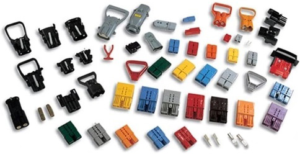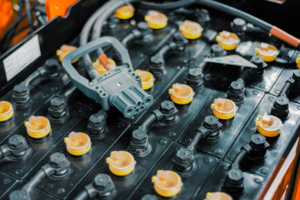Battery Connector Type s
s
Most battery chargers don’t come with a battery connector, and if they do, it’s often the standard 350A GRAY connector. This is because there are literally dozens of different styles available.
An electric forklift battery connector can come in various shapes, sizes and colours. This article covers the most common versions and the generic terms used to describe them.
These battery connectors are commonly used on electric forklift trucks as well as other types of electric vehicles such as material handling equipment, ground-support vehicles and golf carts.
The connectors can broadly be split into 2 categories, flat connectors and Euro-DIN connectors.
This electric forklift battery connector features “flat wipe technology” contacts. Originally designed by Anderson Power Products, the connector is called the “Anderson Connector.”
The same contact and connector design is used for the battery, charger, and vehicle. Assembly and use are simplified because the connectors and contacts are considered “genderless.”
To connect the 2 connectors, you rotate one connector 180 degrees to connect to the other. This contact type provides a large conductive surface area and has a sacrificial tip that allows for high-current circuit breaks when connecting and disconnecting connectors.
A stainless steel spring holds the mating connector in place, creating pressure and friction between the contacts. The contacts are designed for a life of 10,000 connections.
During assembly, the contacts are typically crimped to the forklift battery cable or, less commonly, soldered to the battery cable.
The flat forklift battery connector housings are available in different colors to indicate the voltage and application they are used for. They have a mechanical key molded into the connector housing that prevents accidental pairing of the 2 different colors.
The recommended connector color codes and voltages are:

Colors (suggested, but not always adhered to):
Yellow = 12v
Orange = 18v
Red = 24v
Gray = 36v (most common color used, often used for other voltages)
Blue = 48v
Green = 72v
Black = 80v (this connector can connect to all other colors as well)
Brown = 96v (very rare in the forklift industry)
Purple = 120v (very rare in the forklift industry)
DIN (Euro) STYLE CONNECTORS
 These are becoming an industry standard connector. There aren’t color variations (typically only made in black), instead there is a pin that is rotated within the housing that keys it to allow only specific voltage connections. These connectors also have optional additional pins for data communication.
These are becoming an industry standard connector. There aren’t color variations (typically only made in black), instead there is a pin that is rotated within the housing that keys it to allow only specific voltage connections. These connectors also have optional additional pins for data communication.
DIN320 – (approximately 5” Long by 3-1/2” Wide) 320A max. Found on many newer forklifts.
DIN160 – (approximately 4” Long by 2-1/2” Wide) 160A max. Found mostly on pallet jacks and walkie stackers.
DIN80 – Rarely found in the US.
The components that are available for the Euro-DIN battery, charger, and vehicle connectors are:
They come in 3 primary sizes, each for a given maximum amperage:
The main manufacturers of this type of forklift battery connector are:
Damage to forklift battery connectors, contacts, and cables can affect their performance, service life, and safety. The following is a list of routine inspections that should be performed at appropriate intervals by battery and connector manufacturer guidelines.
Always check manufacturer and company safety guidelines before beginning maintenance or repair activities. Always stay safe and report problems as they are found.
The Euro-DIN connector’s “molded” version, called MRC, is used on some electric forklifts. These letters stand for molded REMA connectors. The design and current manufacturer of the MRC cable is Rema Group. The design of this connector/cable assembly does not allow it to be repaired. If the connector and cable are damaged, replacing it equally or with a more standard cable assembly is the only viable option.
The advantage of the MRC forklift battery connector is that it is very simple to replace in the event of damage by loosening the harness from the battery.
With Anderson “flat” connectors, the contact surfaces are over-wiped during engagement and disengagement, which helps keep the contact surface area clean. The visual inspection will show if any dirt is present, and if so, wipe the contacts clean. Lubricate the connector with grease suitable for metal-to-metal applications, such as white lithium.
For Euro-DIN type forklift connectors, check for any dirt on the female socket or male pins.
Forklift battery connector contacts are crimped to the battery/charging cable as standard. Visually inspect the crimp and check that it is adequate and not loose.
If the connector becomes dirty or is frequently disconnected under load, it may cause the contact to show signs of pitting. Once pitting is present, it may cause pitting on other contacts during the mating/disconnecting process. If a dent is found in the contact, it needs to be replaced.
A common cause of pitting is when the battery is disconnected from the charger while the battery is still charging. This can create an arc that dents the contacts.
We should periodically inspect the connector plastic housing for damage, such as cracks, melting, and discoloration.
Check the battery and charging cables for signs of damage, including bare copper wires and cracked or broken cables.
Check that the battery and charger handle is secure and show no signs of damage.